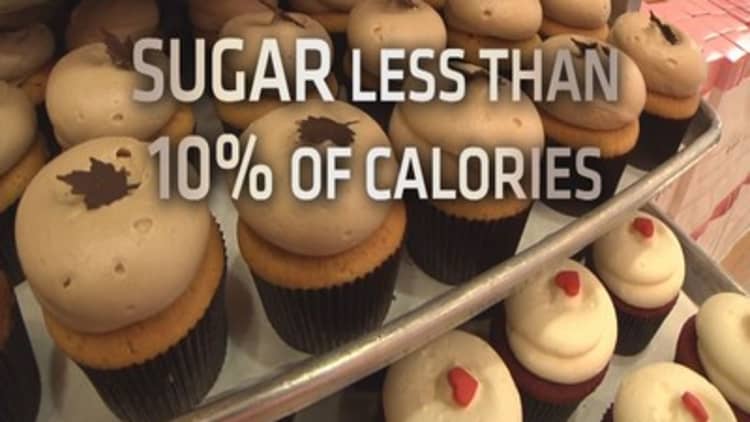
For the first time ever, the federal government is telling Americans to limit their consumption of added sugar to no more than 10 percent of daily calories. Naturally occurring sugars found in vegetables and fruits are permissible, but Uncle Sam now suggests that consumers also regulate their intake of sugar in processed foods
Based on a 2,000 calorie per day diet, this allows for just 200 calories from added sugar—the equivalent of one 12 ounce can of Coke that contains 140 calories.
The guidelines are issued every five years by health officials, and normally come with a heaping portion of controversy. The new edict is no different: Less than a week after the guidance was issued, a lawsuit was filed that sought to overturn it.
Food watchers tell CNBC it's all part of the politics surrounding food and dieting.
"It's a miracle these things even come out because they are overseen by the Department of Agriculture, which doesn't even have to be lobbied to promote meat, dairy, and big food," author and investigative journalist Michael Moss told "On the Money" recently. "It's their job, it's their mission."
The dietary guidelines are part of the "My Plate" initiative, which replaced the food pyramid in 2010, and is meant to illustrate the building blocks of a balanced, healthy meal. The USDA says more than 80 percent of Americans are not getting enough vegetables in their diet.
Other notable changes in this year's report, which partly spurred the legal challenge, include the removal of a recommended limit on cholesterol-rich foods. In a boost to caffeine junkies, officials now say drinking coffee (up to 5 cups a day) can in fact be a part of a healthy diet.
As for meat, the guidelines aren't specific, even as some health advocates have argued vigorously for curtailing meat intake. USDA officials do say dieters should cut back on saturated fats, which can be found in meat, poultry and dairy.
Organizations like the World Health Organization explicitly state to cut out processed meats entirely. Hot dogs, sausage and bacon increases your risk of colon cancer, according to the WHO. http://www.who.int/features/qa/cancer-red-meat/en/
However, people like restaurateur Joe Bastianich say common sense is the best guide. "I think it's about moderation, whether they allow you to drink a couple of more cups of coffee or have a couple more scrambled eggs," he told CNBC. "I think the overall tone is one of moderation."
According to Bastianich, change is already happening in the restaurant industry. He notes that one of the factors leading that is food prices, which have put a damper on both demand and supply. Last year, retail beef prices hit a record high, according to USDA figures.
"You're seeing less of the giant steaks, pork chops and giant chickens. Proteins are getting smaller because they cost too much," he said. "People have to limit what they charge people for a dish of food."
Bastianich added: "The balance of the fine dining plate is really leading the charge, and there's a trickle down from there to quick service and to fast food, and that's a good trend."
Moss notes economics are driving the big food companies to change as well. "All of the big food giants have been reporting dismal earnings and they are scrambling to respond to this growing concern by everybody about what we put in our mouths and our bodies."
Bastianich also touted the health benefits of wine. He noted that the caloric intake for a glass of a dry white wine like Pinot Grigio is only about 100-150 calories, and it's low on sugar.
So go ahead and have a glass—just remember moderation is key.
On the Money airs on CNBC Saturdays at 5:30 am ET, or check listings for air times in local markets.





